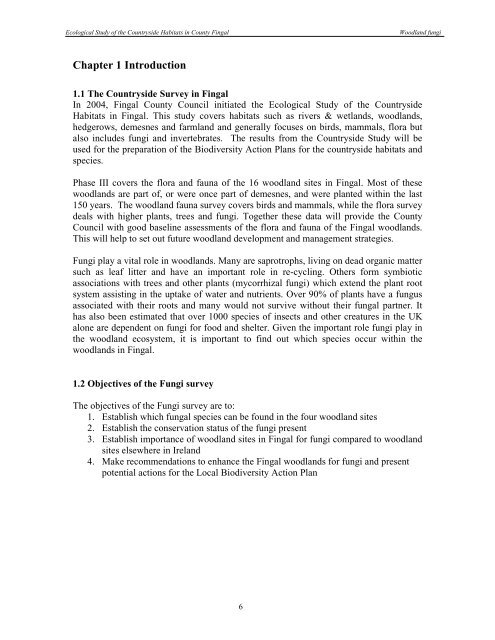2006 Fungi of Fingal Woodlands - Fingal Biodiversity
2006 Fungi of Fingal Woodlands - Fingal Biodiversity
2006 Fungi of Fingal Woodlands - Fingal Biodiversity
Create successful ePaper yourself
Turn your PDF publications into a flip-book with our unique Google optimized e-Paper software.
Ecological Study <strong>of</strong> the Countryside Habitats in County <strong>Fingal</strong> Woodland fungi<br />
Chapter 1 Introduction<br />
1.1 The Countryside Survey in <strong>Fingal</strong><br />
In 2004, <strong>Fingal</strong> County Council initiated the Ecological Study <strong>of</strong> the Countryside<br />
Habitats in <strong>Fingal</strong>. This study covers habitats such as rivers & wetlands, woodlands,<br />
hedgerows, demesnes and farmland and generally focuses on birds, mammals, flora but<br />
also includes fungi and invertebrates. The results from the Countryside Study will be<br />
used for the preparation <strong>of</strong> the <strong>Biodiversity</strong> Action Plans for the countryside habitats and<br />
species.<br />
Phase III covers the flora and fauna <strong>of</strong> the 16 woodland sites in <strong>Fingal</strong>. Most <strong>of</strong> these<br />
woodlands are part <strong>of</strong>, or were once part <strong>of</strong> demesnes, and were planted within the last<br />
150 years. The woodland fauna survey covers birds and mammals, while the flora survey<br />
deals with higher plants, trees and fungi. Together these data will provide the County<br />
Council with good baseline assessments <strong>of</strong> the flora and fauna <strong>of</strong> the <strong>Fingal</strong> woodlands.<br />
This will help to set out future woodland development and management strategies.<br />
<strong>Fungi</strong> play a vital role in woodlands. Many are saprotrophs, living on dead organic matter<br />
such as leaf litter and have an important role in re-cycling. Others form symbiotic<br />
associations with trees and other plants (mycorrhizal fungi) which extend the plant root<br />
system assisting in the uptake <strong>of</strong> water and nutrients. Over 90% <strong>of</strong> plants have a fungus<br />
associated with their roots and many would not survive without their fungal partner. It<br />
has also been estimated that over 1000 species <strong>of</strong> insects and other creatures in the UK<br />
alone are dependent on fungi for food and shelter. Given the important role fungi play in<br />
the woodland ecosystem, it is important to find out which species occur within the<br />
woodlands in <strong>Fingal</strong>.<br />
1.2 Objectives <strong>of</strong> the <strong>Fungi</strong> survey<br />
The objectives <strong>of</strong> the <strong>Fungi</strong> survey are to:<br />
1. Establish which fungal species can be found in the four woodland sites<br />
2. Establish the conservation status <strong>of</strong> the fungi present<br />
3. Establish importance <strong>of</strong> woodland sites in <strong>Fingal</strong> for fungi compared to woodland<br />
sites elsewhere in Ireland<br />
4. Make recommendations to enhance the <strong>Fingal</strong> woodlands for fungi and present<br />
potential actions for the Local <strong>Biodiversity</strong> Action Plan<br />
6


